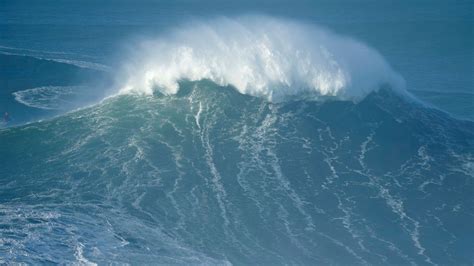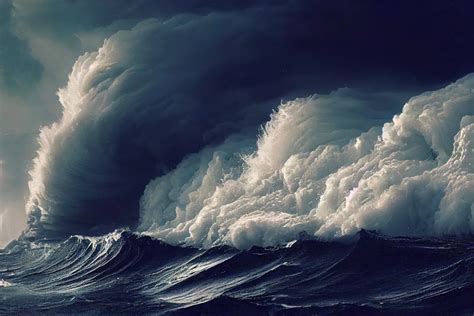
A 60-foot rogue wave, a marine phenomenon long spoken of but rarely documented, was captured on video in the Pacific Ocean, providing a stark visual representation of the ocean’s unpredictable power. The dramatic footage, recently released, highlights the sheer scale and potential danger these unexpected walls of water pose to maritime activities.
The colossal wave was recorded by a remotely operated vehicle (ROV) working in the open ocean. While the exact location remains somewhat unspecified, reports confirm it occurred somewhere within the vast expanse of the Pacific. The video quickly circulated online, drawing attention from both the scientific community and the general public, captivated by the raw force of nature on display. Scientists are examining the footage to better understand the dynamics of rogue wave formation, contributing to improved forecasting models and safety measures for ships and offshore structures.
Rogue waves, also known as freak waves or episodic waves, are defined as waves that are more than twice the significant wave height in a given sea state. This means they are disproportionately large compared to the surrounding waves, appearing suddenly and unexpectedly. Historically, rogue waves were considered maritime folklore, with sailors recounting tales of monstrous waves that seemed to appear out of nowhere. However, the existence of rogue waves was definitively confirmed in 1995 by the “Draupner wave,” measured at an oil platform in the North Sea. This event marked a turning point, spurring further research into the mechanisms behind rogue wave formation.
Several factors can contribute to the formation of rogue waves. One common mechanism is constructive interference, where multiple smaller waves converge and combine their energy to create a single, much larger wave. This can occur when waves traveling in the same direction with similar wavelengths meet, causing their amplitudes to add together. Another factor is wave focusing, which can happen when waves encounter changing currents or bathymetry (the underwater topography). These interactions can cause waves to converge and amplify, leading to the formation of rogue waves. Additionally, nonlinear effects, which are complex interactions between waves, can also play a role in the creation of these extreme events. Wind forcing, particularly in areas with strong winds blowing against the prevailing wave direction, can also contribute to the generation of rogue waves by increasing wave energy and steepness.
The recent documentation of the 60-foot rogue wave provides valuable data for researchers studying these phenomena. By analyzing the video, scientists can gain insights into the wave’s shape, speed, and energy content, which can help to refine existing models of rogue wave formation. This information is crucial for improving forecasting accuracy and developing strategies to mitigate the risks associated with these waves. For example, better forecasting models could allow ships to avoid areas where rogue waves are likely to occur, and improved structural designs could make offshore platforms more resistant to the impact of these extreme waves.
The implications of rogue waves extend beyond the immediate danger they pose to ships and offshore structures. These waves can also have significant impacts on coastal communities, causing erosion, flooding, and damage to infrastructure. The increased frequency and intensity of extreme weather events, potentially linked to climate change, may also increase the likelihood of rogue wave formation in some regions. Therefore, understanding and predicting rogue waves is essential for protecting both maritime assets and coastal populations.
The video of the 60-foot rogue wave serves as a powerful reminder of the ocean’s immense power and unpredictability. It underscores the importance of ongoing research into rogue wave formation and the need for improved safety measures to protect those who work and live near the sea. The event also highlights the critical role of technology, such as remotely operated vehicles, in providing valuable data for scientific study.
The confirmed existence and now visual evidence of the immense size and power of rogue waves necessitate advancements in safety protocols for maritime industries. These protocols must include updated ship designs capable of withstanding extreme wave forces and enhanced training for seafarers to recognize and respond to potential rogue wave encounters. Furthermore, investment in real-time monitoring systems and predictive models is crucial for providing timely warnings and enabling proactive avoidance strategies. By combining scientific research, technological innovation, and improved safety measures, the maritime community can mitigate the risks posed by rogue waves and ensure the safety of lives and property at sea. The recent video evidence also reinforces the necessity of continued collaboration among researchers, industry stakeholders, and policymakers to develop comprehensive strategies for addressing the challenges posed by these extreme ocean events.
The global shipping industry, a vital component of international trade, faces significant risks from rogue waves. The sudden appearance and immense force of these waves can cause catastrophic damage to ships, leading to loss of cargo, environmental pollution, and, most tragically, loss of life. In addition to the direct impact on ships, rogue waves can also disrupt shipping routes and cause delays in the delivery of goods, impacting global supply chains. The economic consequences of these disruptions can be substantial, affecting businesses and consumers worldwide. Furthermore, the insurance industry faces significant liabilities related to rogue wave incidents, adding to the financial burden. Therefore, addressing the risks posed by rogue waves is not only a matter of safety but also a matter of economic stability.
The offshore energy industry, responsible for extracting oil and gas from the ocean floor, also faces considerable challenges from rogue waves. Offshore platforms and drilling rigs are particularly vulnerable to the impact of these waves, which can cause structural damage, equipment failures, and environmental disasters. The consequences of a rogue wave striking an offshore platform can be devastating, leading to oil spills, explosions, and loss of life. Furthermore, the repair and replacement of damaged infrastructure can be extremely costly and time-consuming, disrupting energy production and impacting global energy markets. Therefore, ensuring the safety and resilience of offshore energy infrastructure in the face of rogue waves is of paramount importance.
Coastal communities around the world are also at risk from rogue waves, which can cause coastal erosion, flooding, and damage to infrastructure. The impact of these waves can be particularly severe in low-lying coastal areas, where even a relatively small increase in sea level can lead to significant inundation. Rogue waves can also damage or destroy coastal defenses, such as seawalls and breakwaters, leaving communities even more vulnerable to future storm surges and sea-level rise. The economic consequences of rogue wave impacts on coastal communities can be substantial, affecting tourism, fishing, and other industries. Therefore, protecting coastal communities from the risks posed by rogue waves requires a combination of structural and non-structural measures, including the construction of coastal defenses, the implementation of land-use planning regulations, and the development of early warning systems.
The scientific community continues to dedicate significant resources to studying rogue wave formation and behavior. Researchers are using a variety of tools and techniques, including numerical modeling, laboratory experiments, and field observations, to gain a better understanding of these phenomena. Numerical models are used to simulate the complex interactions between waves, currents, and wind that can lead to the formation of rogue waves. Laboratory experiments are used to study the behavior of waves under controlled conditions, allowing researchers to isolate and analyze specific factors that contribute to rogue wave formation. Field observations, such as the recent video of the 60-foot rogue wave, provide valuable real-world data that can be used to validate and improve numerical models. By combining these different approaches, scientists are making significant progress in understanding rogue waves and developing more accurate forecasting models.
One of the key challenges in rogue wave research is the rarity and unpredictability of these events. Rogue waves occur infrequently and in unpredictable locations, making it difficult to collect data and validate models. However, recent advances in technology, such as satellite altimetry and wave buoys, are providing new opportunities for monitoring and studying rogue waves. Satellite altimetry can be used to measure the height of waves from space, providing a global overview of wave conditions. Wave buoys can be deployed in specific locations to collect detailed data on wave height, period, and direction. By combining data from these different sources, scientists can gain a more comprehensive understanding of rogue waves and improve forecasting accuracy.
International collaboration is essential for advancing rogue wave research and developing effective mitigation strategies. Researchers from different countries are working together to share data, develop models, and conduct experiments. International organizations, such as the World Meteorological Organization (WMO) and the International Maritime Organization (IMO), are playing a key role in coordinating research efforts and promoting the implementation of safety measures. By working together, the international community can reduce the risks posed by rogue waves and ensure the safety of lives and property at sea.
The documentation of the 60-foot rogue wave serves as a call to action for the maritime community, highlighting the urgent need for improved safety measures and increased research efforts. While rogue waves have always been a part of the ocean environment, the potential for increased frequency and intensity due to climate change makes it even more important to understand and mitigate the risks. By investing in research, technology, and safety measures, we can protect lives, property, and the environment from the devastating impacts of rogue waves. The ocean remains a powerful and unpredictable force, but with knowledge and preparedness, we can navigate its challenges and ensure a safer future for all who depend on it. This incident highlights the crucial need to update weather monitoring and forecasting technologies to better detect and predict such extreme weather events, allowing ships and coastal communities to prepare and minimize potential damages. The investment into such technologies would not only improve safety but also lead to more efficient maritime operations.
The increased public awareness generated by the viral video can be leveraged to advocate for greater funding and support for rogue wave research. By educating the public about the risks posed by these extreme events, we can create a groundswell of support for policies and initiatives that will help to protect lives and property. The media also has a crucial role to play in raising awareness and disseminating information about rogue waves. By reporting on rogue wave events and highlighting the importance of research and safety measures, the media can help to inform the public and influence policy decisions.
The impact of a 60-foot rogue wave is substantial, not only due to its immediate destructive force but also because of the potential cascading effects on various industries and communities. The immediate impact on a ship caught in such a wave could range from structural damage to complete capsizing, potentially resulting in significant cargo loss and environmental pollution. The economic repercussions of such an incident can be felt globally, affecting supply chains and insurance premiums.
Moreover, the long-term psychological impact on individuals who have experienced a rogue wave encounter should not be underestimated. Seafarers who survive such events may suffer from post-traumatic stress disorder (PTSD) and other mental health issues, requiring access to counseling and support services. The maritime industry has a responsibility to provide these services to its employees and to promote a culture of mental health awareness.
The engineering community is also actively involved in addressing the challenges posed by rogue waves. Engineers are developing new ship designs and offshore structures that are more resistant to the impact of these extreme waves. They are also working on developing new materials and construction techniques that can withstand the forces exerted by rogue waves. Furthermore, engineers are involved in the design and implementation of coastal defenses, such as seawalls and breakwaters, that can protect coastal communities from the impact of rogue waves.
One promising area of research is the development of metamaterials, which are artificial materials with properties not found in nature. Metamaterials can be designed to absorb or redirect wave energy, potentially providing a means of mitigating the impact of rogue waves on ships and offshore structures. However, the development and deployment of metamaterials for rogue wave mitigation is still in its early stages and requires further research and development.
Another area of focus is the development of advanced warning systems that can provide timely alerts about the potential for rogue wave formation. These systems rely on a combination of real-time monitoring data, numerical models, and machine learning algorithms to predict the occurrence of rogue waves. The challenges in developing such systems include the rarity and unpredictability of rogue waves, as well as the need for accurate and reliable data. However, recent advances in technology are making it possible to develop more sophisticated and effective warning systems.
The ethical considerations surrounding rogue wave research and mitigation are also important. It is essential to ensure that research is conducted in a responsible and ethical manner, with due consideration for the potential impacts on the environment and local communities. Furthermore, it is important to ensure that the benefits of rogue wave mitigation are distributed equitably, so that all communities have access to the resources and technologies they need to protect themselves from these extreme events.
The historical context of rogue wave understanding is significant. For centuries, sailors recounted tales of massive, unexpected waves, often dismissed as exaggeration or maritime folklore. However, the scientific confirmation of rogue waves in the 1990s revolutionized our understanding of ocean dynamics. This validation has spurred significant advancements in research and technology, leading to more accurate forecasting models and improved safety measures.
The future of rogue wave research and mitigation is promising. With continued investment in research, technology, and international collaboration, we can make significant progress in understanding and predicting these extreme events. By developing more effective mitigation strategies, we can protect lives, property, and the environment from the devastating impacts of rogue waves. The ocean remains a challenging and unpredictable environment, but with knowledge and preparedness, we can navigate its challenges and ensure a safer future for all who depend on it. The ongoing advancements in artificial intelligence and machine learning offer the potential to develop even more sophisticated warning systems, capable of predicting rogue wave formation with greater accuracy and lead time. This would enable proactive measures to be taken, minimizing the risk to maritime operations and coastal communities.
FAQ Section:
Frequently Asked Questions (FAQ) About Rogue Waves
-
What exactly is a rogue wave?
- A rogue wave, also known as a freak wave or episodic wave, is defined as a wave that is more than twice the significant wave height in a given sea state. This means it is disproportionately large compared to the surrounding waves, appearing suddenly and unexpectedly.
-
How are rogue waves formed?
- Several factors can contribute to the formation of rogue waves, including constructive interference (where smaller waves combine), wave focusing (due to currents or bathymetry), nonlinear effects (complex wave interactions), and wind forcing.
-
Where are rogue waves most likely to occur?
- Rogue waves can occur in any ocean, but certain areas are known to be more prone to them. These include regions with strong currents, complex bathymetry, and areas where strong winds blow against the prevailing wave direction. The Agulhas Current off the coast of South Africa and the Gulf Stream in the North Atlantic are known hotspots.
-
How dangerous are rogue waves?
- Rogue waves pose a significant threat to ships, offshore structures, and coastal communities. They can cause structural damage, flooding, and loss of life. The sudden appearance and immense force of these waves make them particularly dangerous.
-
What is being done to predict and prevent damage from rogue waves?
- Scientists are using numerical modeling, laboratory experiments, and field observations to study rogue wave formation and behavior. They are also developing advanced warning systems that can provide timely alerts about the potential for rogue wave formation. Engineers are designing ships and offshore structures that are more resistant to the impact of rogue waves. International collaboration is also essential for advancing research and developing effective mitigation strategies.








